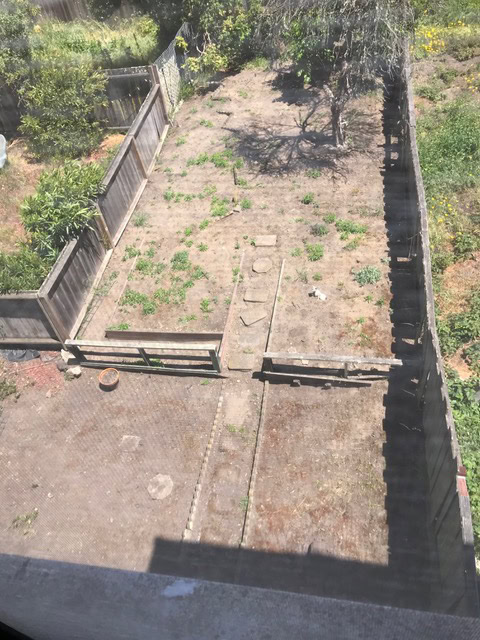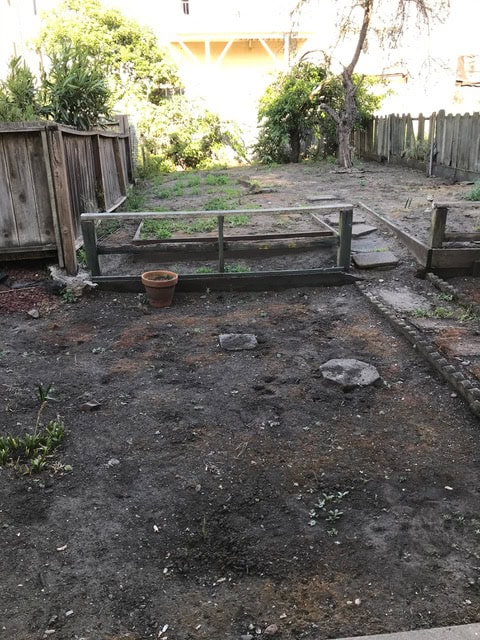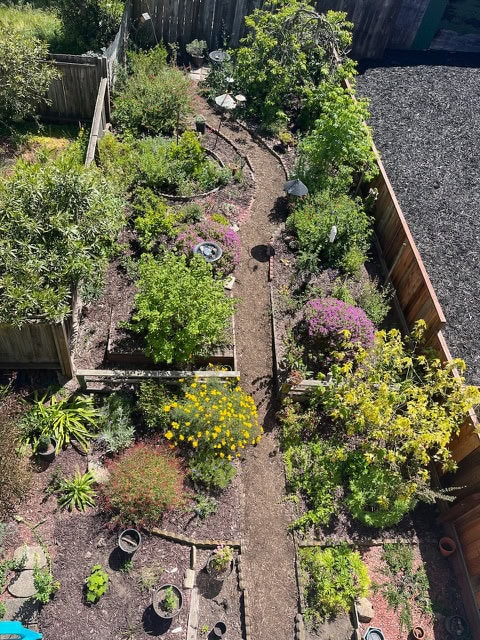A Renter’s Mostly-Native Garden
By Deborah Underwood
Why on earth would a renter plant a garden? Why would anyone spend time, energy, and money to improve someone else’s property?
Five years ago, I had no idea. But now I do.
Flashback to 2020: Each month, men my landlord hired came by to chop down and spray all the weeds in our building’s large backyard. I hated their noisy visits; I preferred the weed-riddled lot to the barren patch of destruction they left.
In April, I learned they were spraying Roundup. Roundup! I asked if they’d stop if I pulled all the weeds. The main guy looked at the yard speculatively, shook his head, then said, “That would be a lot of work.”
He wasn’t wrong.
But I had to try. I bought a weed puller and slowly cleared the space. Wise Facebook friends thankfully nixed my original thought, which was to cover the yard with ground cloth. They told me cardboard flats topped by mulch would help suppress weeds.

I figured I’d put in a pathway before I mulched, and maybe a few plants, too. Neighbors on the Nextdoor site donated pavers. They also offered a variety of plant starts, which I gratefully accepted.

At first, my plants were a random collection: things I’d been given and things I picked up at a nursery because I thought they were pretty. I knew nothing about water needs or soil requirements. I didn’t know how sunlight changed in the yard over the course of the year. I had no help and a limited budget. And I had no organizing plan for the garden.
Thankfully, I stumbled upon some great native gardening lectures on the San Francisco Public Library’s YouTube site. I learned about the importance of native plants to our ecosystem, and got some good plant suggestions. As an animal lover, I finally had a plan: I wanted a wildlife garden, one that would provide food and shelter for birds, and food for the caterpillars and bugs that birds eat.
Calscape.org told me how many species various plants support, and I tried to go for the biggest bang for the buck. I picked the brains of people in native plant nurseries. I watched more online lectures.

Natives, it turns out, tend to be less fussy: good news for newbie gardeners. As some of my original plants kicked the bucket, I replaced them with natives. I gave away the prima donna lemon tree and replaced it with a Pacific wax myrtle. I donated the tea tree a friend gave me and put a beaked hazelnut in its place.
As I watched my garden grow and the birds come, I got more savvy. I looked for low-water plants. When I noticed how much the birds rely on height and cover from a neighbor’s dying tree, I raced out and got two more elderberry plants, quick-growers that will give the birds places to perch and berries to eat.
Now, almost five years on, I have a thriving wildlife refuge. Juncos, House Finches, and Mourning Doves visit daily. Red-tailed and Red-shouldered Hawks drop by to dine on the occasional unfortunate rat or gopher. Every time I see a bird perch on a plant that wasn’t there a few years ago, or watch my resident hummer drink from a winter-blooming flowering currant, I can’t tell you how happy it makes me.
I still have some non-native plants—after I saw a bushtit flock repeatedly visiting my abutilon, I knew it was here to stay—but at last count, my native plants number nearly 70.
I still make tons of mistakes. I will never consider myself a true gardener: I’m just someone who wanted to make a patch of earth a little more planet-friendly.
I’d love to see more renters do this. There are several hurdles: helping people understand why it’s important, giving them tools to proceed, and navigating landlord permissions.
But I think the biggest hurdle is the one it took a pandemic to lift me over: why should a renter bother? Who knows how long a renter will live where they do?
It wasn’t until a few months ago that I looked around my garden and realized this: tomorrow isn’t promised to any of us, renter or property owner. It doesn’t matter if my garden is around in ten years, although I sure hope it will be.
What matters is that I’ve made a place that’s good for the birds—and for me—today, right now. I think the White-crowned Sparrow sitting in the elderberry would agree.
Deborah Underwood is a children’s author who lives and birds in San Francisco. You can visit her online at deborahunderwoodbooks.com.
